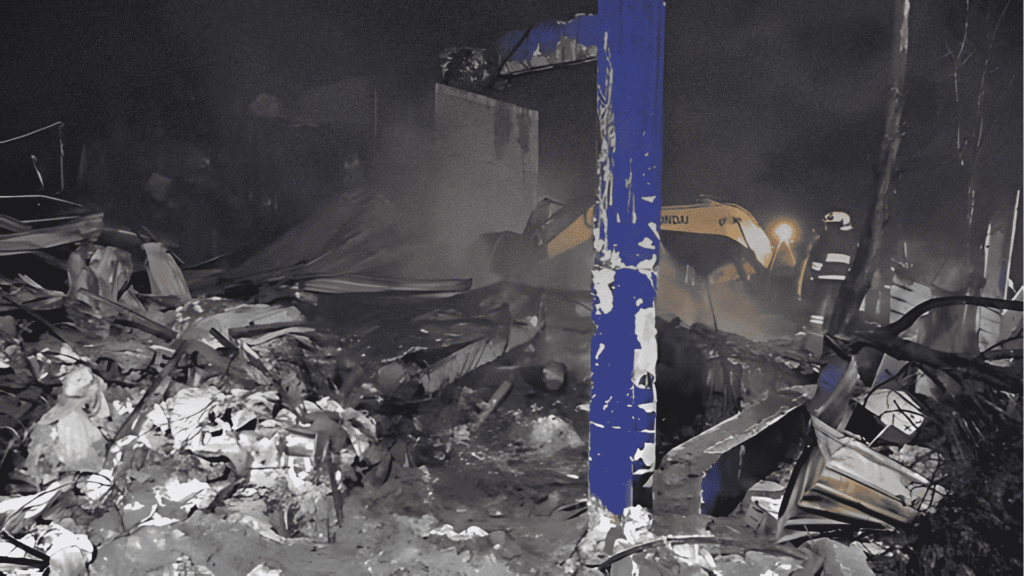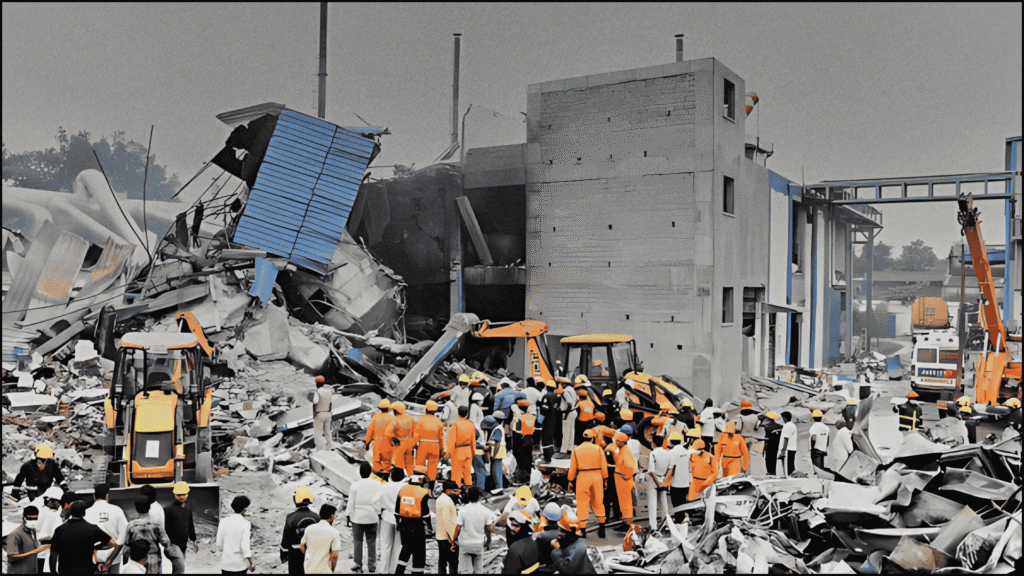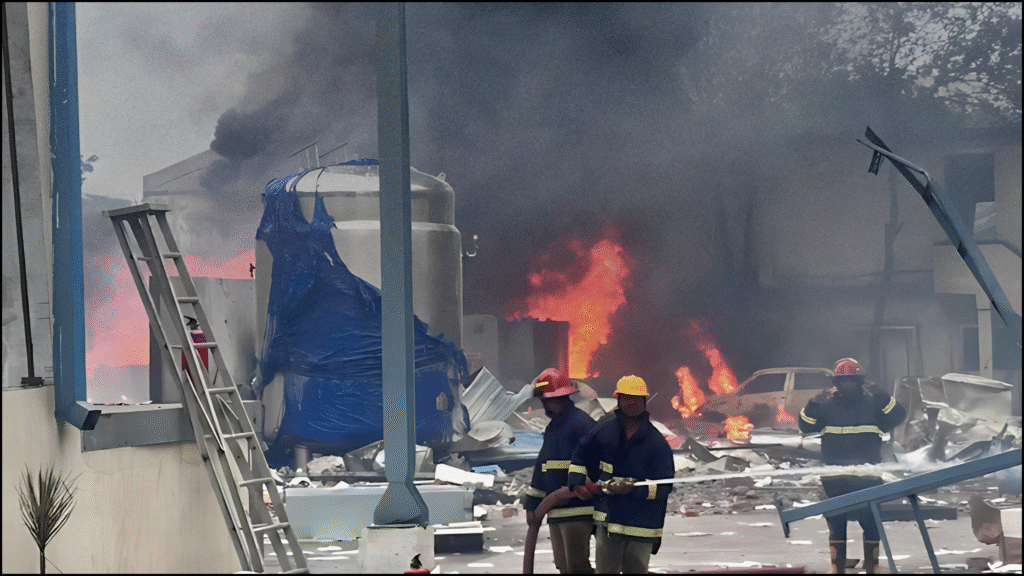On the morning of June 30, 2025, a catastrophic explosion tore through Sigachi Industries Pvt. Ltd., a pharmaceutical manufacturing unit in the Pashamylaram industrial area of Sangareddy district, Telangana, approximately 50 km from Hyderabad. The incident, described as one of the worst industrial disasters in Telangana’s history, has left a profound impact, with a death toll reported as high as 44, dozens injured, and several workers still unaccounted for. This tragedy has not only shattered families but also reignited critical discussions about industrial safety standards in India’s pharmaceutical sector.
The Incident: A Devastating Explosion
The explosion occurred around 9:10 a.m. in the Microcrystalline Cellulose (MCC) drying unit of Sigachi Industries, a company known for producing active pharmaceutical ingredients (APIs), excipients, and nutraceuticals. Preliminary investigations point to a pressure buildup in a spray dryer, a machine used to convert liquids into dried powder, as the likely cause. Experts suggest that fine chemical dust particles accelerated the blast, triggering a massive fire that caused a three-storey production unit to collapse, trapping workers under debris. The blast was so powerful that it was heard up to five kilometers away, shattering windows in nearby offices and sending plumes of thick, toxic smoke into the air.
At the time of the explosion, approximately 145 to 189 workers were present at the facility, many of whom were migrant laborers from states like Bihar, Uttar Pradesh, Odisha, and West Bengal. The majority were working 12-hour shifts, a common practice in the factory. The sudden and violent nature of the explosion caught workers off guard, with some reportedly thrown up to 100 meters by the force. Emergency services, including the National Disaster Response Force (NDRF), State Disaster Response Force (SDRF), and local fire departments, were mobilized swiftly, deploying over ten fire tenders to douse the flames and rescue survivors. Despite their efforts, heavy rainfall complicated operations, and the death toll continued to rise as bodies were recovered from the rubble.
The Human Toll and Aftermath

As of July 1, 2025, reports indicate that at least 44 workers lost their lives, with 31 bodies recovered from the debris and others succumbing to severe burns and injuries in hospitals. Around 35 workers sustained critical injuries, including burns ranging from 40% to 80%, with many requiring ventilator support. The exact number of missing workers remains uncertain, with estimates ranging from 17 to 27, as rescue operations continue. The majority of the victims were migrant workers, leaving families in distant states grappling with grief and uncertainty. Distraught relatives, like Rukmini, who cried, “Mera beta nahi mil raha!” (“I can’t find my son!”), gathered outside the barricaded site, desperate for news of their loved ones.
Hospitals in the area, such as Pranaam Hospitals in Miyapur and Dhruva Hospitals in Patancheru, were overwhelmed, receiving dozens of patients with severe burns and head injuries. DNA testing has been ordered to identify charred remains, underscoring the horrific extent of the disaster. The emotional toll on families is compounded by logistical challenges, as many lack information about the total number of workers present due to missing key personnel, including the vice president of operations.
Government and Corporate Response
Telangana Chief Minister A. Revanth Reddy visited the site on July 1, describing the incident as unprecedented in the state’s history. He announced an ex-gratia payment of ₹1 crore for the families of deceased workers, ₹10 lakh for those incapacitated, and ₹5 lakh for those with partial burns. Additionally, ₹1 lakh was provided as immediate relief to families of the deceased and ₹50,000 to the injured. The state government has pledged to cover medical expenses and ensure the education of victims’ children in government residential schools. A high-level, five-member committee, comprising senior officials from various departments, has been formed to investigate the cause and recommend safety measures to prevent future tragedies.
Prime Minister Narendra Modi also expressed condolences, announcing an ex-gratia payment of ₹2 lakh from the Prime Minister’s National Relief Fund (PMNRF) for the kin of each deceased worker and ₹50,000 for the injured. Sigachi Industries, meanwhile, has suspended operations at the Pashamylaram plant for approximately 90 days to repair damaged equipment and infrastructure. The company’s stock plummeted nearly 20% on July 1, reflecting investor concerns about the financial and reputational fallout.
Safety Concerns and Accountability

The blast has exposed significant safety lapses in Telangana’s industrial sector, particularly in the Pashamylaram-Patancheru corridor, which has seen multiple accidents in recent years. Allegations of inadequate safety protocols and missing operational licenses have surfaced, with local leaders like Patancheru MLA Mahipal Reddy accusing the management of negligence. Experts have pointed to the failure to regularly clean and maintain the blow air handler in the spray dryer, which may have led to temperatures soaring to 700–800°C, far beyond safe limits. This incident follows at least 10 major industrial blasts in Telangana over the past 30 months, raising urgent questions about regulatory oversight and enforcement.
The state government has vowed to conduct safety inspections across all chemical companies and take stringent action against those responsible. A police case has been registered against Sigachi Industries’ management following a complaint by a victim’s family member, signaling potential legal repercussions.
A Call for Reform
The Sigachi Industries explosion is a stark reminder of the risks faced by workers in India’s pharmaceutical and chemical industries, where rapid growth often outpaces safety measures. The tragedy underscores the need for stricter regulations, regular safety audits, and mandatory training for workers. It also highlights the plight of migrant workers, who form the backbone of such industries but often work in hazardous conditions with little recourse.
As rescue operations continue and investigations unfold, the focus must shift to preventing such disasters. The government, industry, and civil society must collaborate to enforce robust safety standards, ensure accountability, and provide comprehensive support to affected families. The loss of lives in Pashamylaram is not just a statistic but a call to action to prioritize human safety over profit in India’s industrial landscape.
Related Articles
Telangana Blasts and Kolkata Scandal: India Faces Twin Tragedies




Pingback: Tragic Factory Blasts and Kolkata Investigation Shake India - cutizensbrain